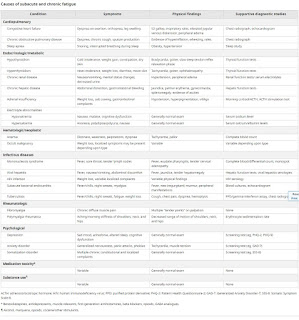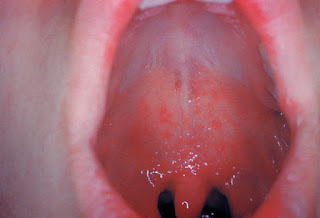Approach to the Adult Patient with Fatigue
Definition
Acute fatigue is defined as lasting one month or less, subacute fatigue as lasting between one and six months, and chronic fatigue as lasting over six months. Patients can have a state of chronic fatigue without meeting criteria for chronic fatigue syndrome (CFS).
Epidemiology
The prevalence of fatigue in population-based surveys in Britain and the United States is between 6.0 and 7.5 percent.
History and Physical Examination
The initial evaluation of the patient with fatigue should include a thorough history and physical examination. The history should focus on the following:
- The duration, severity, and pattern of the fatigue
- Any associated symptoms, such as pain, weakness, shortness of breath, or sleep disturbances
- The patient's medical history, including any chronic illnesses or recent infections
- The patient's medication history
- The patient's lifestyle habits, such as smoking, alcohol use, and exercise
The physical examination should focus on the following:
- General appearance and overall health
- Vital signs, including heart rate, blood pressure, respiratory rate, and temperature
- HEENT, neck, chest, abdomen, and extremity examinations
Laboratory Studies
The following laboratory studies may be helpful in evaluating the patient with fatigue:
- Complete blood count (CBC) with differential
- Comprehensive metabolic panel (CMP)
- Thyroid function tests
- Erythrocyte sedimentation rate (ESR) or C-reactive protein (CRP)
- Urinalysis
- Venereal Disease Research Laboratory (VDRL) or rapid plasma reagin (RPR) test for syphilis
- HIV testing
Other Studies
Other studies that may be helpful in evaluating the patient with fatigue include:
- Electrocardiography (EKG)
- Chest x-ray
- Sleep study
- Exercise stress test
- Magnetic resonance imaging (MRI) or computed tomography (CT) scan of the brain or spine
Differential Diagnosis
The differential diagnosis of fatigue is broad and includes a variety of medical, psychological, and lifestyle-related conditions. Some of the more common causes of fatigue include:
- Medical conditions:
- Anemia
- Chronic obstructive pulmonary disease (COPD)
- Heart failure
- Infection
- Kidney disease
- Liver disease
- Medication side effects
- Myalgic encephalomyelitis/chronic fatigue syndrome (ME/CFS)
- Sleep disorders
- Thyroid disorders
- Psychological conditions:
- Depression
- Anxiety
- Post-traumatic stress disorder (PTSD)
- Somatoform disorders
- Lifestyle-related factors:
- Lack of sleep
- Poor diet
- Sedentary lifestyle
- Substance abuse
Treatment
The treatment of fatigue is directed at the underlying cause. For example, anemia may be treated with iron supplements, COPD may be treated with bronchodilators, and heart failure may be treated with diuretics and ACE inhibitors. In some cases, no specific treatment is available, and the goal of treatment is to manage the symptoms. This may include lifestyle changes, such as getting regular exercise, eating a healthy diet, and getting enough sleep. In some cases, medications may be helpful to improve sleep or reduce anxiety.


.jpeg)


Comments
Post a Comment